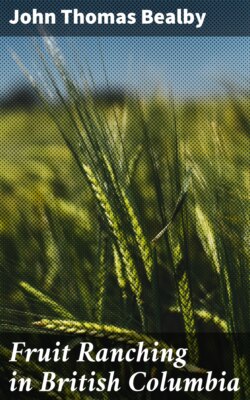Читать книгу Fruit Ranching in British Columbia - John Thomas Bealby - Страница 8
На сайте Литреса книга снята с продажи.
KICKING HORSE RIVER, ROCKY MOUNTAINS.
ОглавлениеFor instance, Professor Shutt, Chemist at the Central Experimental Farm at Ottawa, lecturing on the "Sources of Fertility in Fruit and Vegetable Culture other than Soil," said—and the Professor invariably spoke with professorial carefulness and with almost minute exactness in all his deliverances—that "there was a great future for vegetable and fruit culture in the Kootenays, especially for several species of apples, pears, plums, and cherries. The success of the district here as a fruit-growing one had fairly passed the experimental stage and had been proven." An equally favourable opinion was expressed about the same time by Professor E. R. Lake, of the Oregon Agricultural Experiment Station, a man whose opinion carries considerable weight in the horticultural world.
Testimony of a similar character could be quoted from the lips of several similar more or less competent observers. But let it suffice for me to say I was quite satisfied that the Kootenays was a district well suited, if not, indeed, exceptionally favoured, for the growing of fruit. Moreover, just about this time Earl Grey, Governor-General of Canada, gave convincing proof of the impression which the fruit-growing capabilities of the district had made upon him by purchasing, after personal inspection, 54 acres of fruit land on the shore of the main Kootenay Lake. This was not without its effect upon my view. The vaunts as to the fitness of the Kootenays for growing fruit could not be altogether without foundation after that.
The next questions were—How far the climate could be relied upon? How did it affect the prospects of the crop year by year? What was the effect of late spring frosts? How far cold east or north winds proved injurious? What was the extent of damage done by high winds to the laden trees? Were birds troublesome?
I was told that those varieties of trees which usually bear a crop every year could be safely relied upon for a full crop annually, and that those varieties, such as Blenheim Orange, which in England yield a crop every second year only, would in British Columbia yield, on an average, a full crop one year and half a crop the second year, and so on.
Spring frosts do occur; but they do not in any way seriously affect the fruit trees. "During all the time I have grown fruit beside Lake Kootenay," wrote one of my correspondents, "I can truthfully say I have never lost a cent from this cause." This appears to be perfectly correct. The explanation probably is that, owing to the geographical situation, the trees are somewhat late in blossoming, and do not reach the stage of development at which they become especially susceptible to injury from spring frosts until a time when the frosts are ceasing. Another contributory factor may, no doubt, be discerned in the proximity of the lake, the vapour from which, rising as the air warms in a morning, spreads itself like a protecting veil over the vegetation, including the orchards, which cling to the foot and slopes of the mountains. The early morning sun, again, owing to the narrowness of the lake and the altitude of the encircling mountains, does not shoot his beams directly upon the cultivated lower slopes, but strikes first the summits of the mountains, and then slowly creeps down from the top to the bottom, warming the air before him as he descends, so that when he does at last reach the orchards below, the frost has already been thawed out of them.
Nor, probably, is the diurnal range of the temperature without its effect in providing a certain measure of protection against the "scalding or blighting" influences of the early morning rays. For, though the day may be bright and sunny, and even actually hot, as early as April, or, indeed, earlier, the nights are always, without exception, cool. This wide difference between day and night temperatures, sometimes reaching as high a figure as 40 deg. Fahr., obtains throughout the whole of the year, so that the nights, even after the hottest days of July and August, are refreshingly cool and agreeable. At this season, again, the hottest part of the summer, the lake acts as a sort of regulator, in that the heavy evaporation filters upwards through the orchards, moistening the foliage of the trees and cooling the bark, the blossom, or the fruit, and imparting a certain measure of humidity to the surface of the earth.
As for the winds, one of the most noticeable things that strike the new-comer in the Kootenays is the comparative absence of wind, the prevalent stillness of the atmosphere. This is especially observable, as a rule, at the time when fruit-blossoms are setting, and this is a fact the importance of which must not be overlooked. If fruit-blossoms set well, in still, tranquil, sunny weather, a good crop is pretty certain to follow. The comparative absence of wind will, in a similar manner, account for the smallness of the loss from the dropping of immature or nearly ripe fruit. The comparative immunity from loss in this way must, however, also be attributed to the entire absence of the codlin moth and other insectal and fungoid pests in the Kootenay orchards.
The geographical configuration of the country, the mountains screening the orchards from the quarters whence blow the chilling and injurious winds, accounts perfectly for the safety which the Kootenay fruit-grower enjoys against that dreaded enemy of his English confrère, the East wind and its near ally, the North wind.
